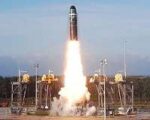The U.S. Department of Defense has awarded Sikorsky, a Lockheed Martin company, a multibillion-dollar contract to build 99 CH-53K King Stallion heavy-lift helicopters for the U.S. Marine Corps (USMC). This large-scale procurement marks a significant milestone in the modernization of the USMC’s vertical lift capability and underscores continued investment in next-generation rotary-wing platforms.
Contract Overview and Strategic Context
On September 27, 2025, the U.S. Navy announced a $9.4 billion firm-fixed-price contract with Sikorsky for the production and delivery of 99 CH-53K helicopters through FY2030 under Lot 7–11 procurement. The deal includes associated support equipment, spares, logistics support, and engineering services.
This award follows previous low-rate initial production (LRIP) contracts that began in FY2019 and transitions the platform into full-rate production (FRP) status as authorized by the Pentagon’s Milestone C decision in December 2022. The CH-53K replaces the aging fleet of CH-53E Super Stallions that have been in service since the early 1980s.
The contract also supports foreign military sales (FMS) potential with options for allied nations such as Israel—already under contract for four aircraft—and Germany, which selected the CH-53K over Boeing’s CH-47F Chinook in July 2023.
CH-53K Capabilities and Design Enhancements
The CH-53K represents a generational leap over its predecessor with a focus on survivability, maintainability, and increased lift capacity:
- Payload Capacity: Capable of lifting over 16 tonnes (36,000 lbs) externally—triple that of the CH-53E—allowing transport of Joint Light Tactical Vehicles (JLTVs), M777 howitzers or up to three standard cargo pallets internally.
- Engines: Powered by three General Electric T408-GE-400 turboshaft engines delivering ~7,500 shp each—63% more power than T64 engines on legacy models.
- Fly-by-Wire Controls: Fully digital flight control system reduces pilot workload and improves handling during degraded visual environments or shipboard operations.
- Composite Rotor Blades: Advanced rotor system with fourth-generation composites increases efficiency while reducing vibration signatures.
- Cargo Systems: Redesigned internal cargo bay with roller floor system enables rapid reconfiguration between troop transport and cargo missions.
The aircraft also includes integrated health monitoring systems for predictive maintenance and is designed to operate effectively in high/hot environments—a key requirement for Indo-Pacific operations.
Operational Role within USMC Force Design
The CH-53K is central to Force Design 2030—the USMC’s modernization blueprint emphasizing distributed operations across contested maritime domains. As peer adversaries like China invest heavily in anti-access/area-denial (A2/AD) capabilities across the Indo-Pacific region, expeditionary mobility becomes critical.
The King Stallion enables rapid deployment of Marines and equipment from sea-based platforms or austere forward operating bases deep inland without reliance on fixed infrastructure. Its ability to self-deploy up to 1,100 nautical miles with aerial refueling further enhances strategic reach.
In addition to amphibious assault roles from LHD/LHA-class ships such as USS America or USS Tripoli, it supports humanitarian assistance/disaster relief (HADR), special operations insertion/extraction missions, and logistics resupply across dispersed island chains—a key enabler for Expeditionary Advanced Base Operations (EABO).
Sustainment Challenges and Cost Considerations
The program has faced scrutiny over cost growth during development. Initial unit flyaway costs were projected at $87 million per aircraft but have since risen above $100 million due to inflationary pressures and supply chain disruptions exacerbated by COVID-era constraints.
Sustainment remains a critical concern; early operational testing revealed issues with component reliability and parts availability which impacted readiness rates below target thresholds (~70%). In response, Sikorsky has implemented predictive maintenance tools via its Integrated Maintenance Data System (IMDS) and expanded depot-level support facilities at MCAS New River and Cherry Point.
The Navy’s Naval Air Systems Command (NAVAIR) is working closely with Sikorsky on performance-based logistics contracts aimed at improving total lifecycle affordability through condition-based maintenance strategies rather than traditional time-based intervals.
International Interest Grows Amid Global Heavy-Lift Gap
The global market for heavy-lift rotorcraft remains limited following retirement or downsizing of Soviet-era Mi-26 fleets in several countries. The CH-47F Chinook fills medium-lift needs but lacks equivalent payload capacity or range compared to the King Stallion.
Israel: Signed an FMS deal via DSCA in late 2021 for four units plus options; deliveries expected by late FY2026.
Germany: Selected CH-53K over Chinook after extensive evaluation citing better survivability features; contract negotiations ongoing as part of its “Schwerer Transporthubschrauber” program.
Japan & South Korea: Have expressed interest amid regional security concerns tied to North Korea and China; no formal RFPs issued yet.
NATO Interoperability: The platform is Link-16 compatible with NATO-standard datalinks enabling joint mission planning across allied task forces.
Sikorsky Production Outlook & Industrial Implications
Sikorsky’s Stratford facility in Connecticut will serve as final assembly line supported by an extensive Tier I/II supplier network across more than 35 U.S. states including GE Aviation (engines), Collins Aerospace (avionics), Spirit AeroSystems (fuselage components), Parker Hannifin (hydraulics), among others.
This order secures production into early next decade sustaining thousands of skilled jobs while reinforcing domestic aerospace supply chains under Buy American provisions embedded in DoD acquisition policy. It also positions Sikorsky favorably ahead of future Army FLRAA decisions despite Bell Textron’s V-280 Valor win under FVL program umbrella—a separate competition focused on tiltrotor technology rather than heavy vertical lift class occupied by H-53 series.
A Platform Built for Future Conflict Environments
The CH-53K is not merely a replacement—it reflects doctrinal shifts toward agile logistics under threat conditions where traditional airlift assets may be denied access or targeted by long-range fires. With hardened survivability features including IR suppression systems, ballistic-tolerant fuel tanks, missile warning sensors integrated into its Defensive Aids Suite (DAS), it is built for contested environments unlike most commercial-derived platforms used elsewhere globally.
Conclusion: Strategic Lift Reimagined
This latest procurement cements the King Stallion as the backbone of Marine Corps heavy lift through mid-century—complementing tiltrotor MV/CV variants while enabling distributed maritime operations across rapidly evolving threat landscapes from Eastern Europe to Western Pacific theaters. As adversaries field longer-range precision munitions and anti-access systems proliferate globally, platforms like the CH-53K will be vital not only for warfighting but also deterrence through credible mobility options embedded within joint force posture planning frameworks.








